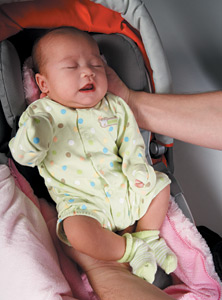Any parent with a newborn to first or second grader knows that car seats are a part of family life. However, many parents may think that if they use the child restraint system required by law, their children will automatically be safe.
Surprising Statistics
Motor-vehicle injuries are the leading cause of death among children in the United States.1 Many of these deaths can be prevented; placing children in age- and size-appropriate car seats and booster seats reduces serious and fatal injuries by more than half.2
In the United States during 2008, 968 children ages 14 years and younger died as occupants in motor-vehicle crashes and approximately 168,000 were injured.2 One CDC study found that in one year, more than 618,000 children ages 0-12 rode in vehicles without the use of a child safety seat, booster seat or seat belt at least some of the time.3
NHTSA Recommendations
 The National Highway Traffic Safety Administration (NHTSA) recommends the following guidelines be followed when deciding how your child should be restrained for their safety whenever riding in a motor vehicle:4
The National Highway Traffic Safety Administration (NHTSA) recommends the following guidelines be followed when deciding how your child should be restrained for their safety whenever riding in a motor vehicle:4
- Infants (birth to at least 1 year of age or weighing at least 20 pounds) are required to be restrained in a rear-facing convertible seat.
- Toddlers (over 1 year of age and weighing 20-40 pounds) need a convertible seat, still rear-facing. Keep your child in a rear-facing position for as long as possible; until they reach the top height/weight limit recommended by the seat maker.
- Young children (ages 4-8 years, unless at least 4' 8" tall and weighing more than 40 pounds) need a seat-belt-positioning booster seat in a forward-facing position.
- The child can sit without a booster seat (shoulder / lap belt only) when the lap belt sits across the upper thighs and the shoulder belt fits across the chest (usually at around age 8 or when at least 4'9" tall).
- Children ages 12 and younger should ride in the back seat at all times.
Additional Safety Features
The pursuit of the perfect car seat has created a variety of systems, checks and balances in the hope of making our children's safety a little more secure. LATCH, an acronym for the "Lower Anchors and Tethers for Children" system, is one of the latest attempts to decrease the risk of an injury during a crash and help minimize problems related to improperly installed car seats.
As of September 2000, all new automobiles (except convertibles) are required to have a special attachment that secures the tether strap found on most new child restraint systems. The purpose of the adjustable strap is to secure the seat to the rear window shelf, floor or back of the vehicle seat. The strap will keep the top of the car seat from moving too far forward, reducing the possibility of head injuries during crashes. In September 2002, a second feature was required: a lower attachment bar with a matching feature on a car seat (buckle, hook or connector) that snaps onto the lower anchor bar of the vehicle.5
SUV Issues
The sport utility vehicle (SUV) is still considered popular these days, partially due to its large size and versatility. Parents also may invest in an SUV because they believe the vehicle's size protects their children (and them) from injury in a crash. Not necessarily so, according to a recent study published in Pediatrics.6
Researchers considered a sample of 3,922 child occupants, ages 0-15, who suffered severe injuries in auto accidents, comparing the injuries sustained by children riding in passenger cars with those riding in SUVs. Severe injuries included, but were not limited to:
- concussions and other brain injuries;
- spinal cord injuries;
- facial fractures and lacerations;
- internal organ injuries;
- extremity fractures; and
- scalp lacerations.
Among all the children in the study, those who were properly restrained were 75 percent less likely to be injured; those who were in the front seat were 106 percent more likely to be seriously injured. In both vehicle types, children exposed to a passenger airbag were 370 percent more likely to be seriously injured, and a rollover crash increased the likelihood of serious injury by 229 percent.
While these numbers may seem average, the real shock came when the rollover crash factor was more thoroughly explored. In any type of auto accident, SUVs were four times more likely to roll over than any other passenger car. Risk of serious injury in an SUV accident increased an average of 2,400 percent for children who were not properly restrained, with the risk being up to 9,253 percent higher.
Child Injury Risk
Just as a seat belt is meant to restrain an adult during an auto accident, the car seat has the same purpose; they are called child restraint systems, not child life preservers, for that very reason. Many parents mistakenly believe that if their child is in a car seat, they are immune from injury during a motor-vehicle collision; in reality, the purpose of the car seat is only to lessen the degree of risk to the child.
Generally, if a child doesn't complain of pain, it never occurs to a pediatrician or parent that any injury was sustained during the collision. Due to their inability to communicate their pain or discomfort, symptoms such as irritability, lethargy, restlessness, night terrors, poor focus and/or appetite, change in bowel movements and being very clingy may be the only signs that an infant or child has suffered an injury.
NHSTA Guidelines for Child Restraints
|
Proper Installation: Make Sure Parents Are Aware
Despite all the best intentions, there is no perfect car seat, safety seat or child restraint system because they all require installation. The NHTSA reports that more than 80 percent of all car seats are improperly installed; when properly installed, they reduce the risk of childhood mortality by 71 percent for infants and 54 percent for children ages 1-4 compared to a child riding completely unrestrained.8
As a family wellness chiropractor, you have an important public safety role to keep parents informed regarding car-seat safety, and this includes information regarding proper installation. Many communities have a certified car-seat inspection facility; you can provide your parents with the following contact information for assistance: 866-SEAT-CHECK (866-732-8243) or www.seatcheck.org.
References
- Centers for Disease Control and Prevention. Injury Prevention and Control: Motor Vehicle Safety. Child Passenger Safety: Fact Sheet.
- Department of Transportation, National Highway Traffic Safety Administration (NHTSA): Traffic Safety Facts 2008.
- Greenspan AI, Dellinger AM, Chen J. Restraint use and seating position among children less than 13 years of age: is it still a problem? Journal of Safety Research, 2010;41:183-185
- Car Seat Recommendations for Children. National Highway Traffic Safety Administration, March 21, 2011.
- Child Safety: The Lower Anchors and Tethers (LATCH) Restraint System. NHTSA: www.nhtsa.gov/Safety/LATCH
- Daley L, Kallan MJ, Arbogast KB, et al. Risk of injury to passengers in sport utility vehicles. Pediatrics, January 2006;117(1):9-14.
- Fysh P. "Children in Auto Accidents." Dynamic Chiropractic, Oct. 22, 1993.
- Motor Vehicle Occupant Injury: Restraint Systems. www.preventinjury.org.
Click here for previous articles by Claudia Anrig, DC.





